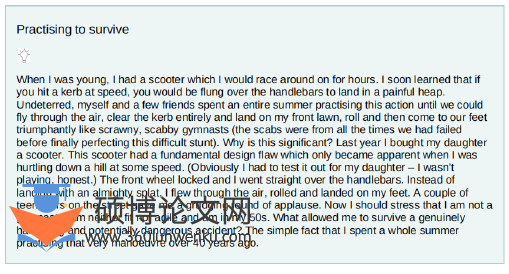本文是一篇英语论文,本翻译实践以德国的功能主义翻译目的论为指导,在信息型文本的翻译过程中,根据目的论的三原则,在词、句、篇三个层面,分别运用适当的翻译技巧解决翻译中所遇到的问题。
Chapter 1 Task Description
1.1 Selection of the Source Text
Play is worth paying more attention because of its benefits. It is necessary to recognize the value of children's play. Play has many different forms, which requires children, parents and educators to know how to choose rewarding play. The play mentioned here refers to rich and colorful activities, different from electronic games. Firstly, play can develop children’s intelligence and improve physical fitness. Play is a good medium for children's healthy growth. Secondly, team spirit can be cultivated and language expression skills can be promoted through communicating with each other in play. Children should be allowed to have a loose playing environment which is beneficial to both body and mind. Thirdly, children can also learn how to face success and setbacks, cultivate the spirit of courage to meet challenges, and develop a positive and optimistic attitude (Li, 2023).
Nowadays, play has a practical educational significance to parents, educators and related people, so they should attach more importance to play in children’s growth due to the common benefits of play. The translator, also as a mother, has a strong interest to play, hoping to have a good knowledge of play. So the book A Very Unusual Journey into Play is chosen to translate, aiming to introduce more information of play to Chinese readers and broaden their horizon.

英语论文怎么写
............................
1.2 Analysis of the Source Text
In order to have a preliminary knowledge of source text, the source text is introduced. Then the features of it are analyzed to make good preparations for translation.
1.2.1 Introduction to A Very Unusual Journey into Play
The book A Very Unusual Journey into Play is committed to giving children a high quality play experience. The potential audience is mainly parents, educators or other social workers who are concerned about the growth of children. This book was published in 2022 by SAGE Publications Ltd and contained eight chapters with more than 50,000 words. The book about children’s play has not been translated by any people before. The author, Ben Kingston-Hughes, is an international keynote speaker, writer and multi-award winning trainer and has appeared on television several times, working on a variety of children’s projects. His distinctive blend of humor and real-life practical experiences has made his training invaluable for anyone working with children.
The book is written based on the author’s thirty years’ experience of working with and observing children. So the views in the book are practical. It states that the moments when children are playing have been the most profoundly significant moments and that over-protecting can harm children’s development, but experiencing controlled risk play can better prepare them for real-life risk.
..........................
Chapter 2 Theoretical Framework
2.1 Overview of Skopos theory
In order to apply Skopos theory into practice, the translator summarized the development of Skopos theory and introduced the three rules respectively.
2.1.1 Development of the Skopos theory
The development of Skopos theory goes through four stages with four representatives as follows: Katharina Reiss, Hans Vermeer, Justa Holtz Manttari and Christine Nord (Jia & Wang, 2012).
The first stage, Katharina Reiss proposed text typology and for the first time brought functionalist approach into criticism. “Criticism should begin with observing the type of text represented, which has significant implications for a valid translation, and then consider both the linguistic and non-linguistic factors which are of essential significance for the translation process” (Reiss, 2000: 16). Reiss regarded translation as integral communicative performance. Besides linguistic factors, communicative function should be considered for translation.
The second stage, Hans Vermeer inherited and developed Reiss’ functionalist theory and established Skopos theory and three rules. Under Skopos theory, translation was defined as “Produce a text at target setting for a target purpose and target addressee in target circumstances” (Nord, 2018: 28). Vermeer believed that translation is purposeful, and all translation activities should follow the skopos rule. The coherence rule is to achieve intratextual coherence of target text. The fidelity rule is to attain intertextual coherence between source and target text.
...........................
2.2 Application of the Skopos Theory in Informative Text Translation
Reiss establishes a connection between three communicative situations and the corresponding language dimensions and text types. Three text types are as follows: informative text that focuses on content, expressive text that focuses on form, and operative text that focuses on appealing to readers (Reiss, 2000). Zhang (2022) translated informative text Exposure Therapy for Children with Anxiety and OCD (Chapter 1-2) under the guidance of Skopos theory. Zhang (2022) explained that “As an informative text, information is more valuable than the form. The author's main purpose is to present information and target readers also care about the correctness of information.” According to three rules of Skopos theory, the informative text was translated and the translation practice was written.
The book A Very Unusual Journey into Play belongs to informative text. Informative text contains the information that the writers want to express. The translation is necessary to be consistent with the meaning expressed in the source text and consistent with the expression habits of Chinese (Wang, 2022).
Skopos theory advocates for achieving expected translation effect, translators need to possess subjective initiative and choose suitable translation methods based on the translation goals. The three rules of Skopos theory can service as the guidance of the translation. For translating lexical words, the fidelity rule is used to guide the translation, to ensure the accuracy of lexical words, faithful to the source text. Translating sentences, the skopos rule aims to reach target readers’ understanding, so the sentences in target text must conform to reading habits of target readers. Meantime, textual translation should be paid more attention under the guidance of the coherence rule. So for communicative purpose, the translator chooses appropriate translation methods and put accurately transmitting information of the source text in the first place rather than blindly pursuing equivalent translation.
.............................
Chapter 3 Translation Process ..................................... 8
3.1 Pre-translation Preparation ............................ 8
3.2 While-translation Procedure ................................ 8
3.3 Post-translation Proofreading .................................. 9
Chapter 4 Case Analysis ....................................... 10
4.1 Application of the Fidelity Rule .......................... 10
4.1.1 Conversion .............................. 10
4.1.2 Paraphrase .............................................. 12
Chapter 5 Conclusion ......................... 31
5.1 Major Gains........................................ 31
5.2 Limitations ................................... 32
Chapter 4 Case Analysis
4.1 Application of the Fidelity Rule
The fidelity rule refers to the intertextual coherence between source and target text, in other words, what the target text means closes to what the source text means (Liu, 2009). “So understanding what the author of the source text tries to convey is of the significant importance” (Zhang, 2022: 13). Intertextual coherence relys on the consistency of the three parts: the first is the information of the source text; the second is how the translator interprets the information; the third is how the translator encodes the information for the readers of the target text.
According to Vermeer (2000), to the extent that a translator judges the form and function of a source text to be basically adequate per se as regards the predetermined skopos in the target culture, we can speak of a degree of “intertextual coherence” between target and source text. This notion thus refers to a relation between target text and source text, defined in terms of the skopos. Under the guidance of the fidelity rule, the translator adopted conversion, paraphrase and annotation to proceed translation at lexical level.

英语论文参考
..............................
Chapter 5 Conclusion
5.1 Major Gains
This translation practice plays an important role in the translator's learning. The fifth and sixth chapters of the book A Very Unusual Journey into Play are translated under the guidance of the Skopos theory, adopting appropriate translation skills according to three rules. So understanding of Skopos theory is the prerequisite for completing the translation task and application of translation techniques according to three rules is the key, thus improving the translation quality.
Therefore, Skopos theory and its three rules are learned and related translation techniques are applied. According to Skopos theory, the purpose of translation behavior determines the entire process of translation. The skopos rule is the primary. So at sentence level, inversion, division and restructuring are applied to adjust sentences’ sequence of the target text for conforming to target readers’ reading habits. Under the coherence rule, translation needs to meet the standards of intra-textual coherence. So at textual level, amplification and omission are adopted to add or delete words, phrases or clauses, for achieving textual coherence of target text. The fidelity rule emphasizes the existence of inter-textual coherence between the original and source text. So at lexical level, conversion, paraphrase and annotation are adapted to make words in the target text close to source text.
In addition, the translator has a new understanding of the application of the Skopos theory in informative text translation. The book A Very Unusual Journey into Play belongs to informative text. So the translation should be consistent with the meaning expressed in the source text and accurately deliver the information to the target readers. The skopos rule, the coherence rule and the fidelity rule separately emphasis the target readers, intra-textual coherence in target text and inter-textual coherence between the original and source text.
reference(omitted)
